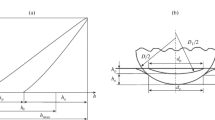Abstract
The impact code EPIC was employed to study the relationship between the applied force and the penetration depth in a micrometer-scale indentation experiment with oxygen free high conductivity (OFHC) copper. EPIC is an elastic-plastic finite element code that uses a Lagrangian formulation and triangular mesh, which can accommodate large deformation without the need to remesh during the computation process. By fitting the force-penetration curves for a triangular indenter with second degree polynomials, it was demonstrated that the fit changed with two material constants in the constitutive equation. A systematic procedure for determining the material constants is described that is based on matching either the slope or the curvature of the force penetration depth curves from numerical simulation and experiments. It is concluded that material constants can be determined from indentation data obtained using pyramidal or spherical indenters as well as a flat-ended indenter.
Similar content being viewed by others
References
D. Newey, M. A. Wilkins, and H. M. Pollock, J. Phys. E. Sci. Instrum. 15, 119–122 (1982).
J. B. Pethica, R. Hutchings, and W. C. Oliver, Philos. Mag. A 48 (4), 593–606 (1983).
M. F. Doerner and W. D. Nix, J. Mater. Res. 1, 601–609 (1986).
W. C. Oliver and C. J. McHargue, Thin Solid Films 161, 117–122 (1988).
K. L. Johnson, Contact Mechanics (Cambridge University Press, Cambridge, MA, 1985).
R. Hill, B. Storakeis, and A. B. Zdunek, Proc. R. Soc. A 423, 301–333 (1989).
C. Hardy, C. N. Baronet, and G. V. Tordion, Int. J. Num. Meth. Eng. 3, 451–462 (1971).
C. H. Lee, S. Masaki, and S. Kobayashi, Int. J. Mech. Sci. 14, 417–426 (1972).
P. S. Follansbee and C. B. Sinclair, Int. J. Solids Structures 20 (1), 81–91 (1984).
K. Komvopoulos, Trans. Am. Soc. Mech. Eng., J. Tribology 111, 430–439 (1989).
A. K. Bhattacharya and W. D. Nix, Int. J. Solids Structures 24 (9), 881–891 (1988).
X. Cai, J. Mater. Sci. Lett. 11 (22), 1527–1531 (1992).
T. A. Laursen and J. C. Simo, J. Mater. Res. 7, 618–626 (1992).
C. E. Anderson, Int. J. Impact Eng. 5, 33–59 (1987).
G. R. Johnson, Trans. Am. Soc. Mech. Eng., J. Appl. Mechanics 43 (3), 439–444 (1976).
J. L. Loubet, J. M. Georges, and G. Meille, in Microindentation Techniques in Materials Science and Engineering, edited by P. J. Blau and B. R. Lawn (ASTM STP 889, 1985), pp. 72–89.
F. Fröhlich, P. Grau, and W. Grellmann, Phys. Status Solidi A 42, 79–89 (1977).
Y-M. Chen, A. W. Ruff, and J. W. Dally, Proc. Symp. on Contact Problems and Surface Interfaces in Manufacturing and Tribological Systems, ASME Winter Annual Meeting (1993).
G. R. Johnson, AIAA J. 17 (9), 975–979 (1979).
T. Belytschko, Computing in Applied Mechanics, ASME, AMD (1976), Vol. 18, pp. 139–161.
G. R. Johnson, D. D. Colby, and D. J. Vavrick, Int. J. Num. Meth. Eng. 14, 1865–1871 (1979).
G. R. Johnson and W. H. Cook, Proc. 7th Int. Symp. on Ballistics, The Hague, The Netherlands (April, 1983), pp. 541–547.
E. W. Mielnik, Metalworking Science and Engineering (McGraw-Hill, New York, 1991).
C. W. Shih, M. Yang, and J. C. M. Li, J. Mater. Res. 6, 2623–2628 (1991).
V. A. Lamb, C. E. Johnson, and N. D. R. Valentine, J. Electrochemical Soc. 117 (9), 291–318 (1970).
Y-M. Chen, Ph.D. Dissertation, University of Maryland, College Park, MD (1993).
F. J. Zerilli and R. W. Armstrong, J. Appl. Phys. 5, 1816–1825 (1987).
J. S. Field and M. V. Swain, J. Mater. Res. 8, 297–306 (1993).
Author information
Authors and Affiliations
Rights and permissions
About this article
Cite this article
Chen, Y.M., Ruff, A.W. & Dally, J.W. A hybrid method for determining material properties from instrumented micro-indentation experiments. Journal of Materials Research 9, 1314–1321 (1994). https://doi.org/10.1557/JMR.1994.1314
Received:
Accepted:
Published:
Issue Date:
DOI: https://doi.org/10.1557/JMR.1994.1314




